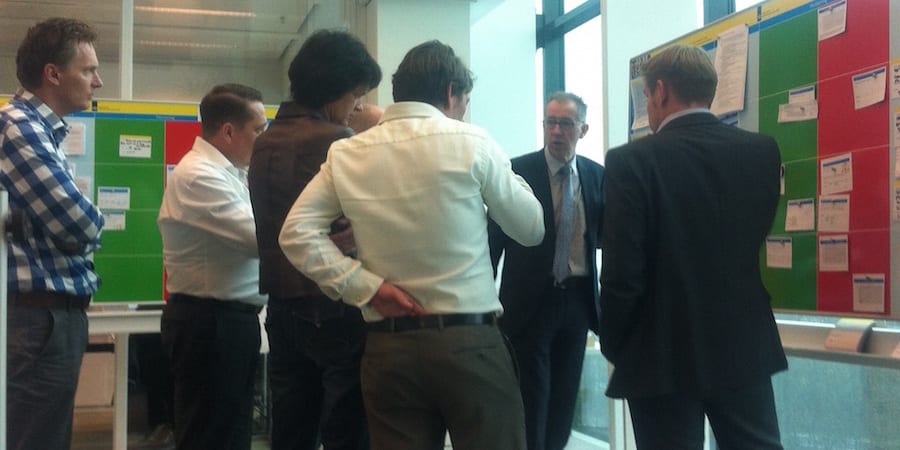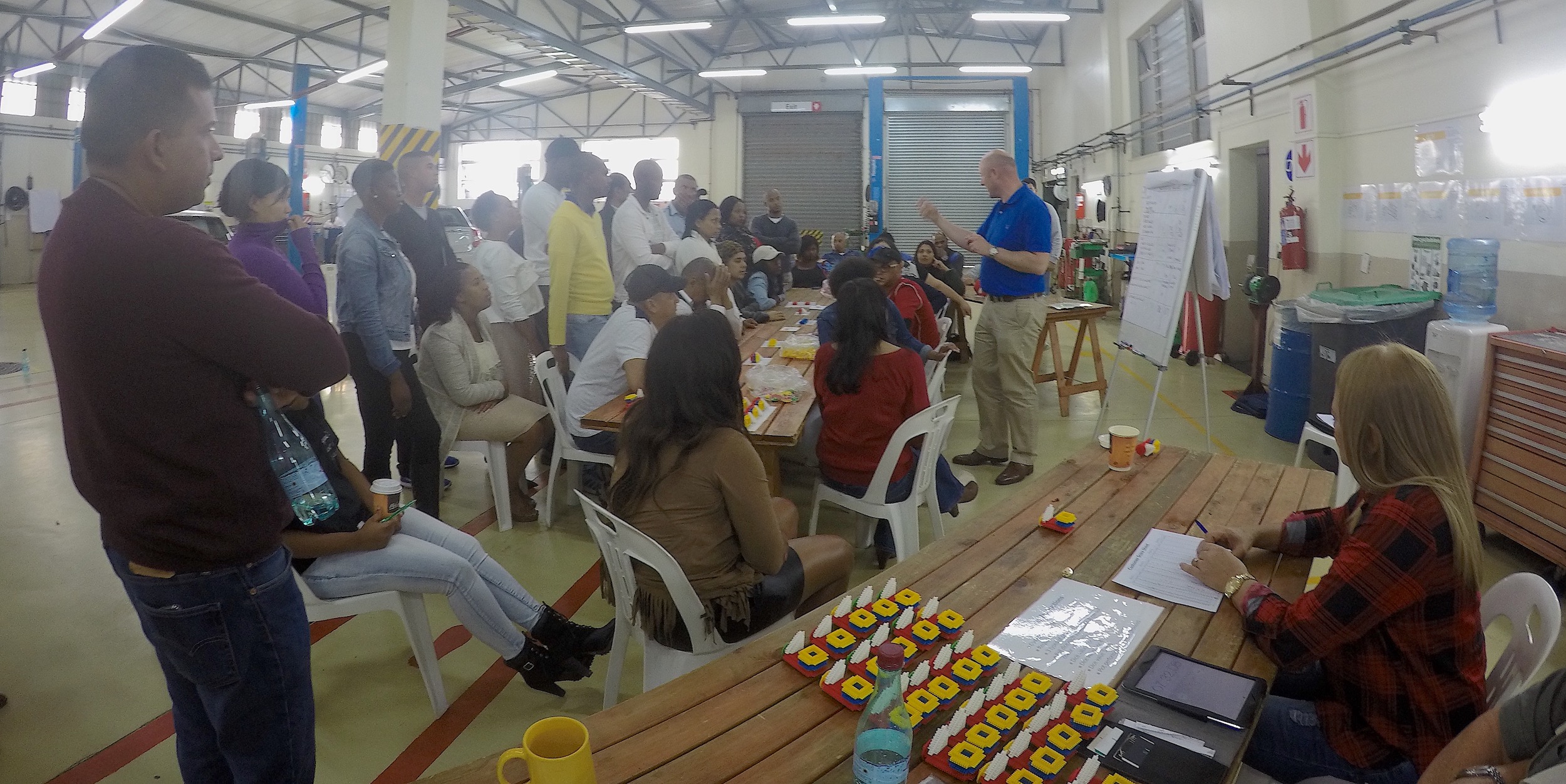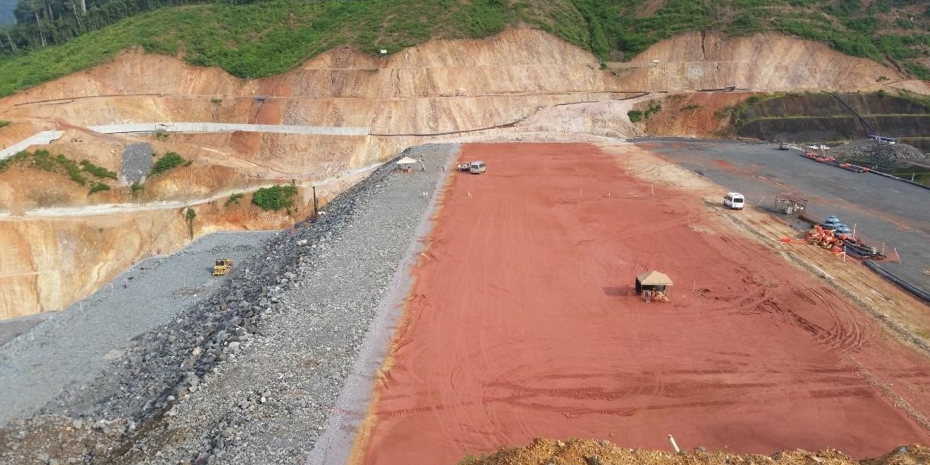
Two years of hoshin at the Dutch Ministry of Infrastructure
FEATURE – The theory of hoshin kanri is clear, but how can you adapt it to a government organization structured in departments where making A3s is not a daily practice? A Dutch ministry shares its experience.
Words: Diana Uphof, lean consultant, Rijkswaterstaat (Ministry of Infrastructure and Environment, the Netherlands)
In many ways, our journey to implement strategy deployment at the Major Projects and Maintenance Department of Rijkswaterstaat felt like walking in thick fog. We took small steps all the time and just when we thought we were starting to see some light in the distance, fog enshrouded us once again.
We were guided (and driven) by the conviction that hoshin would help us to focus on what is really important, but we were not sure how to get there. It took two years of hard work to start to catch a glimpse of our path to improvement and the challenges we face. Our way is now paved with clearly defined goals and monthly measurements that help us steer the ship.
In the Department everyone involved can be extremely proud of what we have achieved so far by taking small steps, reflecting on each of them and improving continuously. We hope this article will help other government organizations to find their own path to improvement.
THE SEARCH FOR FOCUS
Rijkswaterstaat is responsible for the design, construction, management and maintenance of Dutch infrastructure. It employs around 8,800 people and has an annual budget of €5bn.
As a result of the economic crisis and the subsequent reduction in workforce, our department was struggling to keep the level of quality, the planning process and the costs of our projects stable. People were doing a lot of overtime, there was a general lack of focus and everyone seemed to be busy putting out fires. There appeared to be no time to look for solutions that would lead to better overall end results.
We wanted to find a way to focus our efforts on what really mattered and started to wonder whether hoshin kanri could help. We came across the Lean Management Instituut's hoshin model (pictured below) and decided to try and apply it to our organization.
For more on hoshin, read Wiebe Nijdam's article A guide to practical hoshin

The key element of this model is that different management levels in the organization make plans together to solve the problems of the business: at strategic level, directors work with managers; at department level (or value stream level), managers collaborate with team or group leaders; at process level, team and group leaders engage with front line workers.
The role of leader is always the same – to create a common understanding of the issues, to ask for countermeasures, and to mentor people on possible solutions.
As we studied this theoretical model, we asked ourselves if and how it could fit our processes and structure. We then proceeded to visualize it and discuss it with the people around us. After a while, we came to the conclusion that it just seemed too far from our current state. Our organization was not ready to embrace a value stream structure yet, but we still wanted to try to reap the benefits of hoshin. As a starting point, therefore, we decided to use our traditional organizational model (a departmental structure) for the middle level – which is called Value Stream Level in the LMI model.
At the strategic and operational levels the structure of Rijkswaterstaat allowed us to follow the LMI model ad litteram. The graph below highlights the difference between the theoretical model developed by Lean Management Instituut and the adapted version we adopted at Rijkswaterstaat.

To continue our research on how to make it work we built a communication model (see the picture below). We used it to spread the theory, to test our ideas and in the same time to create support among a lot of people in the organization to start with strategy deployment. After a while we (the lean team) were ready to take the next step, knowing that only by doing could we complete our understanding of hoshin. Like John Shook said, "It's easier to act your way into a new way of thinking, than think your way into a new way of acting."
But first we had to overcome one big hurdle: convincing our board members to start this journey. More often than not, resistance arises because people don't really understand a concept and can't see the consequences for themselves. Therefore, we made an extra effort to communicate the model to the board members in a way that fitted their experience and spoke to them: we worked on examples from their own daily routine and explained how these would change if the model were to be applied.
We managed to inspire them, and they gave strategy deployment the green light!

THE START, SEARCHING FOR THE RIGHT GOALS
The first step in the model is identifying goals. So we started to scour our documentation on vision, mission statements, management contracts, etc. in a bid to find goals that would fit the four "macro areas" the theoretical model includes: Safety, Quality, Delivery, and Cost. We asked the board to assign the right level of priority to each of the goals and to select a set for the upcoming year.
To give you an idea, the Primary Goals of Rijkswaterstaat are to be accountable to our Minister, colleagues and contractors, and to provide a dependable infrastructure network.
These were translated into top goals for the Major Projects and Maintenance Department as follows:
- Safety: zero incidents among our people, contractors and civilians that use our infrastructure
With the metric: IF (injury frequency) rate
- Quality: We deliver our projects right first time
With the metric: percentage of reviews that are green the first time
With the metric: number of project points still incomplete
- Delivery: We deliver our projects on time
With the metric: percentage of project milestones reached on time
- Cost: We deliver our project within the given budget
With the metric: project budget and budget for personnel
At this point, we had to determine what actual achievements (in terms of figures) we wanted to get for these goals and what figures we wanted to put on the visual boards. We searched for people in the organization who could provide us with the right data, and asked their opinion on what the biggest obstacles would be in achieving these goals. Not surprisingly, this gave us a wealth of information and helped us to realize how much data actually never reached the Board.
For the following two months, we collected and presented all facts, figures and problems to the members of the board. They got into the habit of starting every meeting looking at the visual information and the ensuing discussions started to give them lots of insight into the current achievements and the biggest problems the department was encountering.
It was the first time the Board experienced the benefits of visualized information organized around the four macro areas of the model (Safety, Quality, Delivery and Cost – or SQDC). With the insight gained they could now select the targets and graphs they wanted to follow on the visual board. After four weeks, the first version of the strategic visual board was complete and the board members started to monitor and discuss monthly progress. Now they could track departmental performance on a monthly basis and react to deviation right away, rather than look back at what already went wrong.
This was the idea...

And this is how we put it into practice...

THE DIALOGUE BETWEEN BOARD MEMBERS AND MIDDLE MANAGEMENT

The theoretical model shows that the power of hoshin kanri lies in the dialogue that occurs between different management levels. So we (the lean team) challenged our board members to start with catchball communication. This method is used to create consensus and alignment on goals and plans between management levels through dialogue.
Board members started the catchball process by taking middle managers to the visual board and asking them for their feedback on the chosen goals and targets. After several iterations, consensus was reached and a final decision made on the goals for the coming year.
Middle managers reported that they were very satisfied with the dialogue and happy to be involved in defining the goals. At the same time, they were discovering new ways to work together as a team.
The next step was to translate the strategic goals identified by the board (with input from the middle managers) into tactical actions that should be performed further down in the organization. Middle managers discussed their contribution to the strategic goals with the Board. This began with investigating the primary purpose and mission of each management team. From there it was possible to formulate each team's specific contribution to organizational goals and determine the problems they could solve from their position.

After six months we created an oobeya with one strategic board and four tactical boards (one for each management team). In the meanwhile we also improved to look and feel of the boards. Our board members convinced us (the lean team) that the experimentation stage was now over – we took that as a hint that the boards would have to look good.
The oobeya (which means "big conference room") is a room or area where all those involved in a process gather and where all the relevant information (targets, plans, deviations/issues) is displayed on the wall in a visual form. It helped us greatly.
FROM TALKING ABOUT FACTS TO TALKING ABOUT IMPROVEMENTS
Board members and management teams started to routinely monitor and discuss the facts and progress standing in front of the visual board. This occurred three times a month. Their focus was mainly on the left side of the board, where the graphs showing data on current achievements are located.
They were still managing in a traditional way: when the figures told them the goals were not being achieved, their first response was to solve the problems by getting into firefighting mode. Needless to say, this was no way of achieving structural improvement.
Luckily, we had a plan to change this.
At this point in time, the visual board was filled with goals, current performance, and our biggest problems. There were no strategic A3s and no analysis of the root causes of our problems. Because everybody saw making an A3 as a huge and very difficult undertaking, we could not persuade people to start using this method in earnest. However, it started to become clear that the many improvement projects we had running were not solving our problems.
Accepting the lack of A3s we decided to visualize all the improvement projects we were running in the organization and tried to place them under the four macro areas of Safety, Quality, Delivery and Cost. This revealed we had over 140 ongoing improvement projects. The Board could not believe it, and once again stressed the importance of getting more focused on really critical items.
What followed was a sorting exercise, trying to identify which projects contributed to the achievement of our goals and which didn't. We got down to 80 projects. The next big question we had was at what level we should monitor the improvements: the Board decided to monitor the top 5 on their visual board, while the rest of the projects were assigned to the different boards of middle managers or divisions.
The board members realized that the sorting exercise was not enough to find which countermeasures were the most effective ones (they still had too many of them to look at). This was the moment they realized why the strategic A3 in the model was so important.
A collaboration experiment was initiated, in which a board member and two middle managers worked together to complete the left side of the A3. In the analysis phase, people from all four management teams came together to look into the problem at hand. This way a horizontal connection was made. This made it clear that the management teams were all struggling with the same issues. As they worked together to formulate the right countermeasures, they also began to look for ways to collaborate on solving probems in a more effective way.
A few months later, four strategic A3s hung to the strategic board, thanks to the joint effort of two management levels. What a victory! While previously our focus and agendas changed every week, visualizing and putting the deployment process in a logical order allowed us to stabilize our scope and zoom in on the vital few, step by step.

THE DEVELOPMENT OF LEAN LEADERSHIP AND DAILY ACCOUNTABILITY
During meetings, board members experimented with their new roles as lean leaders. They practiced asking questions instead of solving problems for others, and started to challenge their middle managers to look for countermeasures. At the same time, middle managers experienced what it means to work in an environment where daily accountability, transparency and short-cycle improvements are the norm. Integrating this new way of working with their routine wasn't always easy because their schedules normally forced them to run around to fight fires all day long. For a long time, it looked like they were maintaining two different management styles at once.
THE ESSENTIAL ROLE OF THE BUSINESS OPERATIONS DIVISION
During the implementation process it became clear that without up-to-date data, monitoring would be impossible. Finding information that tells something about the selected targets and progress of our countermeasures often turned out to be a great challenge because in our environment measuring lead-times, defects and other basic KPIs was not common practice.
We realized that striving for perfection would cost us momentum. Therefore we decided to start visualizing the first basic piece of information we could find. For the countermeasures we made simple cards with the name of the countermeasures and asked people to hang it in the red or green part of the board, based on their gut feeling. All of this was intended to simply get the performance dialogue going. We gradually found ways to improve the information on the boards.
Our Business Operations division took on the responsibility to improve and generate the data and provided monthly updates. Their role is essential, because without data the meetings by the board would be completely useless.
After a while, their role started to change: while previously they struggled to get the right data on performance and produced a lot of reports of which the headlines were the only thing people actually read. Now the division had become an active part of the dialogue in front of the visual board and the board members consulted with them to obtain background information. In return they were more in touch with the needs of the Board and able to deliver better management information.
CONNECTING TO THE OPERATIONAL LEVEL
The last step in establishing hoshin at all management levels is to extend the system to operations.
To do this, middle managers started to talk with their peoples about the specific contribution to the organizational goals. However, we gradually discovered we had to define, standardize and stabilize each division's processes before we could discern any actual contribution.
As we started to do this, managers began to understand how important their involvement with their people is. Observing what they do, the processes they follow and the main problems they face is critical. We are still working on it.
Our hypothesis is that when the processes are explicit enough and each division can easily perform their daily work, managers will be able to decide what the divisional targets on Safety, Quality, Delivery and Costs should be, and how the problems identified at the strategic and tactical level can actually be solved.
We are still far from there, but when we eventually get there alignment will be complete.

TO SUMMARIZE
The model took us on a journey that helped us to focus on our most important goals and start a dialogue across the organization (both vertically and horizontally). It helped us to see our real problems and to develop synergy and collaboration. Along the way we learned to search for real facts and solve our problems using A3 thinking, and our managers developed their lean skills. Looking back, we realize how much the model taught us about lean.
If you feel inspired and are thinking about starting a similar journey in your organization, here are a few things you should be aware of (they made it work for us):
- We created a communication model so that people could really understand the concepts we were explaining and see the implications for themselves. It can also be used to simulate how it can work in your organization.
- If the theoretical model doesn't fit your organization right away, look for a way to develop the model into what you exactly need, step by step. We decided to use our traditional organization model (departmental structure) as a first step. Every situation is different, and your approach should reflect this.
- The strategic A3 is essential because it represents the connection between goals and countermeasures. We decided to ignore the A3 the first year because we couldn't get people to work with them, but after a while we realized it was the missing element of the equation.
- The business division has an essential role, because without up-to-date information the board meetings are useless.
- The development of lean leadership and daily accountability is not about implementing a model or changing an organization, but about changing behavior. Now and then we stepped in the shoes of our management team to really understand what they were going through and realized how hard it really was to make this change happen. This insight gave us the patience we needed.
THE AUTHOR

Read more


INTERVIEW - Planet Lean speaks with Constantin May, Academic Director of the CEPTM institute at Germany’s Ansbach University, which organized the first Lean Educator Conference in Europe in co-operation with LGN.


INTERVIEW – The Lean Enterprise Academy just launched the Lean Learning Journey, an online platform from which practitioners can pull the practical knowledge they need in their lean transformation.


CASE STUDY – The turning point in this Colombian construction company’s transformation came when they started to embrace lean as a culture rather than just a set of tools.


FEATURE – How lean daily management helped a Brazilian construction company to stabilize production in a tailing dam elevation project.

